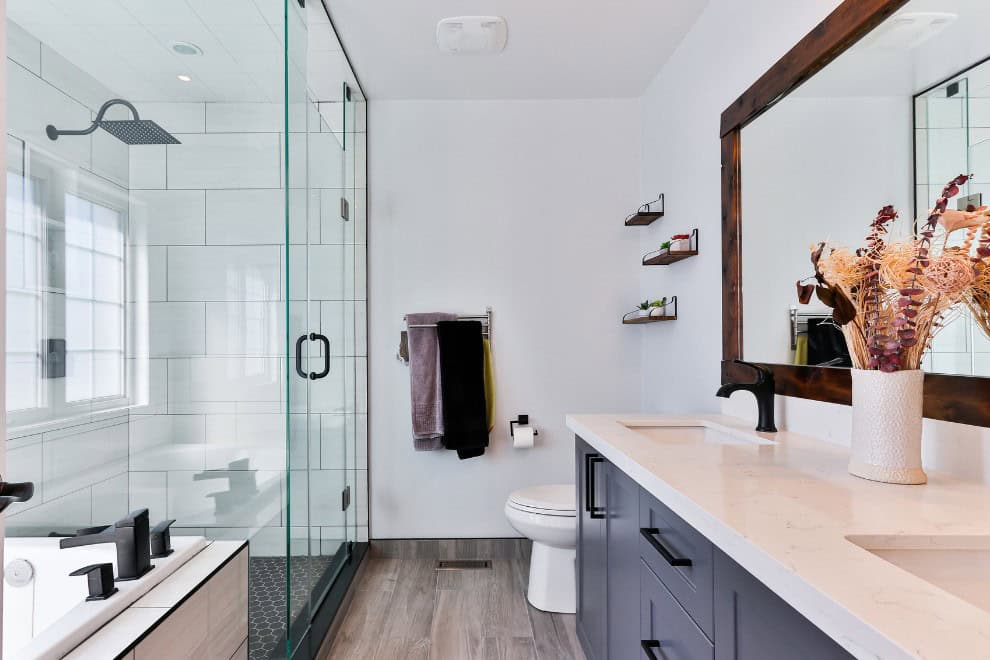Bathrooms need to be practical, so well throughout planning is key to successful renovations and making the most out of limited space. The good news is that anyone can design the perfect bathroom. They prove this each week on reality TV.
Here are seven simple steps for avoiding bathroom renovation mistakes and designing the perfect space:
1.Create Your Bathroom Renovation Wishlist

Every bathroom renovation starts with a list. Jot down the essential amenities along with everything you hope to achieve with your new renovations: double vanity, heated towel racks, mirror lighting, etc.
Think hard about your current setup. What do you like and what do you want to change? Do you need more storage space? Are you satisfied with the shower height from the floor? Where will you hang wet towels? There’s a lot to consider, which is why you should start with a wishlist. You can expand and whittling down the list as you go along.
2.Make Sure You Draw Up a Floor Plan
You don’t need to be a visual artist to draw a basic floor plan. Its purpose is to help you visualize your new bathroom and make sure your grand ambitions don’t exceed the limits of the space.
Use a tape measure to find the room’s dimensions and take note of the size of your current bath, toilet, shower and so forth. This way, you will have a good idea of what amenities can fit within your bathroom.
3.Cost of a Bathroom Renovation
It’s estimated that the average American bathroom renovation will set you back between $5,000 and $10,000. If your budget doesn’t reach these heights, it might be time to cross out some non-essential items on the wishlist.
Quality budget bathroom renovations are possible without having to give up on your hopes and dreams. You could save money by taking on a few DIY jobs like removing the existing tiles and repainting.
Changing the basic layout of the room will make your renovations more expensive, but can also improve the practicality of the space. If you need to relocate water access and drainage, the tradespeople at Metropolitan Plumbing come recommended.
4.Seeking Bathroom Inspiration
It’s time to choose a style: contemporary, Scandinavian, industrial, rustic, traditional, Mediterranean; what will it be? Picking a style or theme now will also help narrow down the choice of fittings, fixtures, wall tiles and colors.
Inspiration can be found everywhere. Explore magazines, websites, social media, showrooms, brochures and TV.
When you do pick a style, stick with it. If you start mixing 1960s tiles with country style faucets and modern lighting, you could end up with a hot mess on your hands.
5.Go Online Shopping
Once you’ve chosen a style, it’s time to go shopping. There’s no shortage of bathroom amenities and accessories to suit all price ranges, so be sure to shop around.
Choosing bathroom tiles to suit your style is arguably the most important step, as they are featured prominently throughout the room. Then work on the bath, shower, toilet, vanity and mirror before focusing on the taps and other fittings that complement your chosen style.
Be sure to consider each amenity’s dimensions and refer to and alter your renovation floor plan as required.
6.Don’t Forget Lighting and Ventilation
Two aspects that are often overlooked when considering renovations are the lighting and ventilation. If the budget permits, consider having different levels of lighting. A bright, heat light for bathing in winter is a great start, and also a dim light for those late night trips to the toilet. A shaving light by the vanity can also be useful. These are also available as mirror lights.
Ventilation is also important. A bathroom that’s not adequately ventilated can cause condensation on surfaces, resulting in mould, along with metal surfaces rusting and wooden accessories rotting. An open window may not be sufficient, and it can raise privacy concerns. That’s why an extractor fan is essential.

7.It’s Time to Call a Plumber
Before you start with the sledgehammer, consult a plumber, electrician and any other experienced tradespeople for a quote and inspection to ensure that you’re not going to damage shower pipes or anything else important.
You can have everything ready to go for when the tradespeople arrive or have them supply and install amenities for you. Even if you want to take on some DIY tasks to save money, consider that all plumbing work and electrical jobs should always be left to the professionals.
And with this guide you should be well on your way to enjoying a bathroom that’s equal parts stunning and functional. Bathroom selfies will become less about you and more about your hard work and smart choices. Overall, the satisfaction that comes from the planning and designing your own space will make going to the bathroom a real treat.

